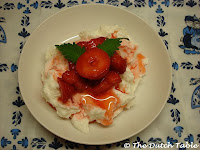Hieronymus van Alphen, the famous Dutch poet who lived from 1746-1803, was especially known for his poetry for children. Even though he only managed to write less than 70 poems for this particular audience, his work ended up translated in French, German, English, Frisian and Malaysian, which for that time was quite a feat.
One of his most celebrated works is a poem called The Plum Tree (De Pruimeboom), about obedience and its rewards. It goes as follows;
Johnny saw some fine plums hanging,
Oh! like eggs, so very large;
Johnny seemed about to pluck them,
Though against his father's charge.
Here is not, said he, my father,
Nor the gard'ner near the tree,
From those boughs so richly laden,
Five or six plums - who can see ?
But I wish to be obedient,
I'll not pluck them; off I go.
Should I for a trifling handful
Disobedient be? Oh no.
Off went Johnny; but his father,
Who had overheard his talk,
Just then forward stepped to meet him,
In the garden middle-walk.
Come, my Johnny, said his father,
Come, my little darling boy,
Now for you some plums I'll gather,
Now you are your father's joy.
Then Pa gave the tree a shaking;
Johnny stooped with laughing face,
Johnny filled his hat quite brimful,
Off then galloped in a race.
For however lovely the poem is, its moral lesson went straight over my head. Only last week I saw gorgeous plums hanging in the neighbor's tree and reached to pick and eat one. Just as I sank my teeth into the sweet flesh, the neighbor walked out the door, grinning. Busted!!!
What could I do? I had a half-eaten fruit in my left hand, purple plum juice dripping down my chin and my right hand was still holding on to the branch of her tree. So I gave her a cheesy grin and shrugged my shoulders. Hey, what can I say? I'm not Johnny :-)
But this week I'm doing penance. Instead of scolding me, the neighbor lady picked two full bags of plums and left them on the porch for me to find. Nice! So I've been in plum heaven this week: I canned plum jam, dehydrated several trays of plum slices and made some yummie plum brandy.
I also wanted to try an old recipe that I found in a Frisian cookbook from 1772, De Welkokende Vriesche Keukenmeid, one of the few recipes that lists plums. For some reason or other plums are not big in the Dutch kitchen and research only gave me two recipes: this one and a traditional Limburgse vlaai made from dark plums.
This recipe for a good old sturdy plum bread pudding, was traditionally a dish made with dried plums (i.e. prunes) and given to new mothers. Apart from the luxury of eggs, milk and sugar that surely did a new mother good, the prunes provided much needed relief from eh...well whatever prunes offer relief from. You know.
But since I didn't need the laxative benefits of a prune pudding (although some people may suggest otherwise) and I found myself with a copious amount of pre-prunes, I decided to make this dish with fresh plums instead. It lends itself to a gorgeously rich, fruity, sweet and slightly tart bread pudding that is wonderful eaten warm out of the oven, with or without a scoop of ice cream.....
Prûmebôle
10 fresh plums
12 slices of old bread
2 eggs
2 cups of milk
1/3 cup of sugar
3 tablespoons of brandy
1 tablespoon of cinnamon
1 tablespoon of orange zest
2 teaspoons of brown sugar
1/2 stick of butter, room temperature
Pinch of salt
Pinch of nutmeg
Butter an 8x8 baking pan. Cut the crust off the slices of bread and spread butter on both sides of the slice. Put four slices of bread on the bottom of the pan.
Slice the plums and distribute half of the slices over the buttered bread pieces in the pan. Sprinkle one third of the cinnamon over the fruit, and half of the orange zest. Place another four slices of bread on top, and divide the rest of the fruit over the bread. Sprinkle another third of cinnamon over the top, add the rest of the orange zest and cover with the last four slices of bread. Sprinkle the rest of the cinnamon on top, and the two teaspoons of sugar.
Beat the milk, the eggs, salt, nutmeg and three tablespoons of brandy into a foamy liquid, on medium high for about four minutes. Pour the milk mixture over the bread in the pan, cover and rest either overnight, or at least for two hours in the fridge. Remove from the fridge while you heat up the oven to 350F.
Place the pan on a baking sheet to catch any juices and bake the bread pudding for at least 45 minutes or until the top is golden. Best eaten warm.













































